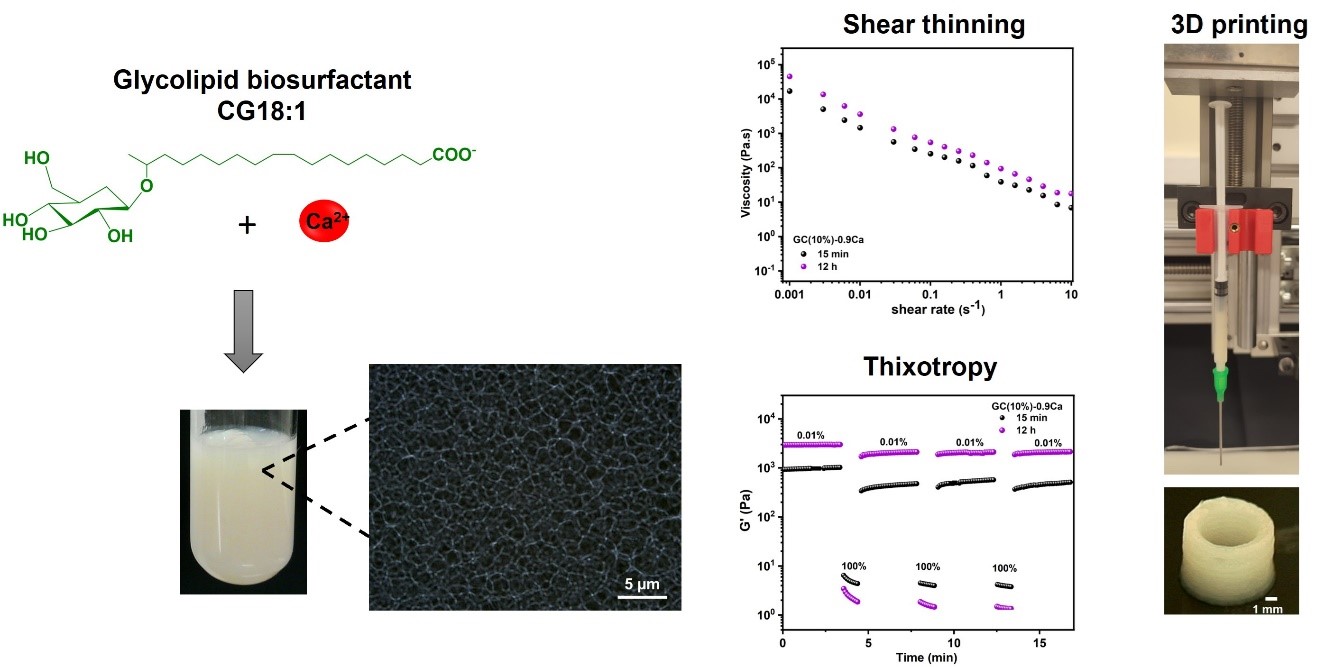- Share
- Share on Facebook
- Share on X
- Share on LinkedIn

Objective
This area of research aims to develop biocompatible supramolecular hydrogens with specific mechanical properties for 3D printing. These hydrogels are obtained from biosurfactants extracted from plants or derived from microorganisms with salt-induced fibrillation. The microscopic structures, gelation dynamics, and mechanical properties that affect printing mechanisms are the key steps in this field. These supramolecular hydrogels have become one of the new challenges in 3D printing technology and have a high potential for application in biological fields such as drug delivery and tissue engineering.
Results
- Process and aging effect on 3D printing of glycoamphiphiles supramolecular hydrogel for potential soft tissue engineering (Collaboration with LCMCP)
Our strategy is to develop supramolecular hydrogels from biosurfactants extracted from microorganisms with salt-induced fibrillation for 3D priting3. Supramolecular hydrogels based on low molecular weight have interesting properties for 3D printing, such as shear thinning behavior, thixotropy, and biocompatibility1. As they are only made up of small molecules and weak interactions, they give rise to soft hydrogels, suitable for the culture of some types of cells that require very soft matrices. They are also expected to be more permeable to cells, facilitating 3D growth2. The rheological characteristics of the supramolecular hydrogels, such as shear thinning behavior, viscoelasticity, and thixotropy, were investigated to optimize the printing process and obtain the desired quality and precision of the product. Different processes for obtaining hydrogels were explored to evaluate the stability and homogeneity of the materials, including the impact of aging time on the printability of various types of hydrogels.

References
-
Lim, J. Y. C.; Lin, Q.; Xue, K.; Loh, X. J. Recent Advances in Supramolecular Hydrogels for Biomedical Applications. Materials Today Advances 2019, 3, 100021. https://doi.org/10.1016/j.mtadv.2019.100021.
-
Chalard, A.; Mauduit, M.; Souleille, S.; Joseph, P.; Malaquin, L.; Fitremann, J. 3D Printing of a Biocompatible Low Molecular Weight Supramolecular Hydrogel by Dimethylsulfoxide Water Solvent Exchange. Additive Manufacturing 2020, 33, 101162. https://doi.org/10.1016/j.addma.2020.101162.
-
Poirier, A.; Le Griel, P.; Hoffmann, I.; Perez, J.; Pernot, P.; Fresnais, J.; Baccile, N. Ca 2+ and Ag + Orient Low-Molecular Weight Amphiphile Self-Assembly into “Nano-Fishnet” Fibrillar Hydrogels with Unusual β-Sheet-like Raft Domains. Soft Matter 2023, 19 (3), 378–393. https://doi.org/10.1039/D2SM01218A.
Personnels impliqués :
- Share
- Share on Facebook
- Share on X
- Share on LinkedIn